Hangul 한과 Revised Romanization hangwa IPA [han.ɡwa] | Hanja 韓菓 McCune–Reischauer han'gwa Hangul 조과 | |
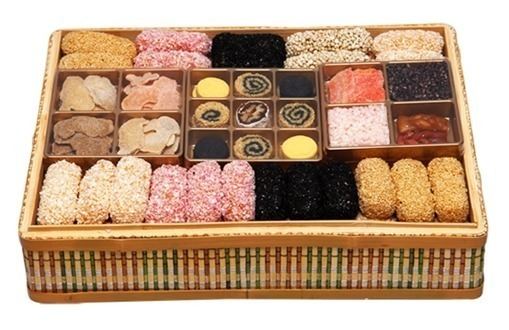 | ||
Similar Yumilgwa, Tteok, Yakgwa, Gangjeong, Instant rice | ||
Explore tv south korea making hangwa traditional cookies
Hangwa (한과; 韓菓; lit. "Korean confectionery") or hangwaryu (한과류; 韓菓類; lit. "Korean confectionery category") is a general term for traditional Korean confectioneries. In Korean, it is also called jogwa (조과; 造果; lit. "crafted fruit") or gwajeongnyu (과정류; 果飣類; lit. "fruit food category"). Confusingly, a type of yugwa is also called by the name hangwa (한과; 漢菓) with a different hanja (Chinese character).
Contents
- Explore tv south korea making hangwa traditional cookies
- 12fly tv rain making korean traditional snack hangwa gangwon
- Types of hangwa
- Candies
- Yeot
- Dasik
- Gwapyeon
- Jeonggwa
- Suksilgwa
- Yullan
- Yeotgangjeong
- Yugwa
- Gangjeong
- Hangwa
- Yumilgwa
- Mandugwa
- Taraegwa
- Yakgwa
- Gotgam mari
- Kkultarae
- Yaksik
- History
- References
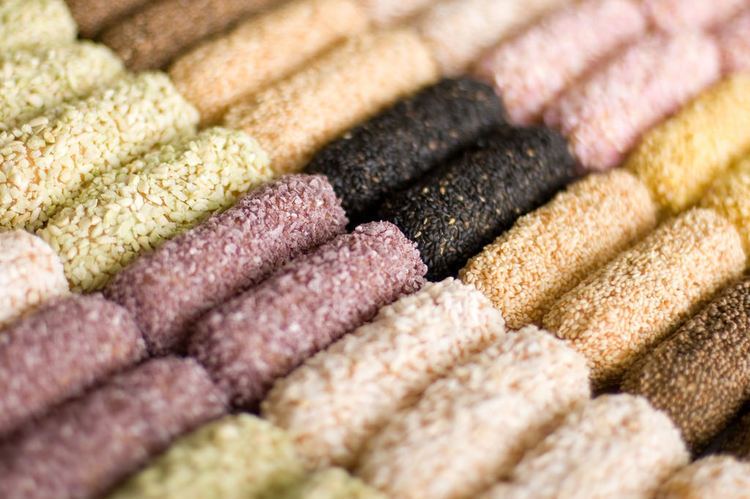
Common ingredients of hangwa include grain flour, edible fruits and roots, sweet ingredients such as honey and yeot, and spices such as cinnamon and ginger.
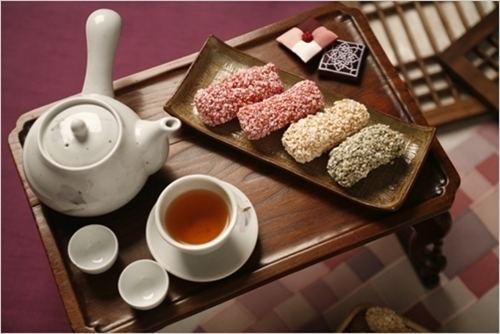
12fly tv rain making korean traditional snack hangwa gangwon
Types of hangwa
Hangwa can be classified into eight big categories, namely dasik, gwapyeon, jeonggwa, suksilgwa, yeotgangjeong, yugwa, yumilgwa, and candies.
Candies

Traditional Korean candies can be eaten as they are, or used as sweetening ingredients in other types of hangwa. Dang (당; 糖; "candy") or Dangryu (당류; 糖類; "candy category") refers to hard and sweet confection. It can be made of crystallized sugar, or saccharified starch. For example, okchundang is made of rice flour.
Yeot

Yeot (엿) is a taffy-like sticky sweet that is made by lightly fermenting cooked rice with powdered barley malt called yeotgireum in water, heating it on a low heat until the rice grains dissolve into the liquid, then reducing it until sticky and solid. If reduced only to syrup-like consistency, it is called mullyeot (물엿; "water yeot") or jocheong (조청; 造淸; "artificial honey") in Korean, and rice syrup in English. Yeot can also be made with other starchy ingredients such as glutinous rice, sorghum, maize, potatoes, sweet potatoes, and pumpkins.
Dasik
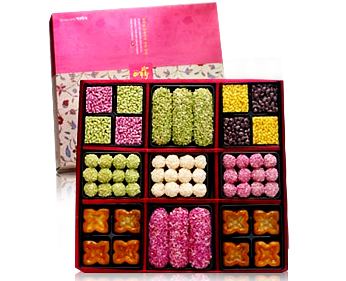
Dasik (다식; 韓菓), literally "tea food", is a bite-size hangwa that is normally accompanied by tea. It can be made by kneading grain or other edible seed flour or pollen with honey, then pressing them into a decorative mould called dasikpan (다식판). Typical ingredients include rice flour, pine pollen, black sesame, chestnut, and soybean.
Gwapyeon
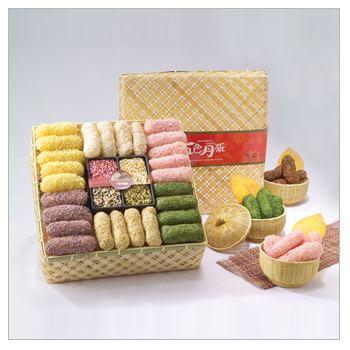
Gwapyeon (과편; 果片) is a jelly-like summer dessert, made by boiling a fruit in water, sieving it, then adding honey and simmering it for a long time on low heat. Starch, agar, or other thickening agent can be used as a time-saver. After boiling, it is cooled in a mould until solidify. Gwapyeon can be made with a variety of fruit, including cherry, bokbunja, apricot, hawthorn, bog blueberry, five-flavour berry, and yuzu.
Jeonggwa
Jeonggwa (정과; 正果) is a crispy, chewy sweet made of candied fruits, roots, or seeds. It can be made by boiling sliced fruits, roots, or seeds in honey, drying the slices, and optionally shaping them into flowers or other decorative forms. Common ingredients include quince, yuzu, lotus root, ginger, winter melon, and ginseng. If water is boiled first with honey (and often with spices such as cinnamon and ginger) and dried fruit is added later, it is called sujeonggwa (수정과; 水正果; "water jeonggwa") and served cold as a beverage.
Suksilgwa
Suksilgwa (숙실과; 熟實果), literally "cooked fruit", is a sweet made by boiling fruits, ginger, or nuts in water, mashing them, and then shaping the mashed fruit into the original shape of the fruit, or other shapes. Common ingredients include chestnut, jujube, and ginger.
Yullan
Yullan (율란; 栗卵) is a type of suksilgwa made of chestnut. It is made by mashing and sieving boiled and peeled chestnuts, mixing the sieved chestnut with honey into a dough, then shaping the dough into chestnut-shaped cookies.
Yeotgangjeong
Yeotgangjeong (엿강정) can be made by adding toasted seeds, nuts, beans, or popped grains to mullyeot (liquid yeot), then spreading the mixture evenly to let it cool. When cooled, it is cut into cubes, parallelepipeds, or other desired shapes. Common ingredients are pine nuts, walnuts, peanuts, sesame or perilla seeds, and popped rice.
Yugwa
Yugwa (유과; 油菓) is a hangwa made by shaping rice or wheat flour dough into small pieces, drying them and deep-frying them, and then coating them with honey or grain syrup followed by popped rice, toasted sesame seeds, etc.
Gangjeong
Gangjeong (강정) making starts with soaking glutinous rice in water for four to five days, then pounding the soaked grains into rice flour. The flour is then kneaded with cheongju (rice wine), honey, and water. The dough is flattened and cut into rectengular or rhombic slices, and soaked in cheongju again, then dried in shade before deep-fried in oil. The hollow rice snack is usually double-fried, and first coated with honey and then with various nuts, seeds, and spice powders.
Hangwa
Hangwa (한과; 漢菓) is a type of yugwa, made by kneading a mixture of flour, and honey or sugar, flattening and frying the dough in oil, and then dyeing it in different colours. Hangwa dyed in five colours are called osaek hangwa (오색한과; 五色漢菓; "five-colour hangwa").
Yumilgwa
Yumilgwa (유밀과; 油蜜菓) refers to fried hangwa made of wheat flour. Different varieties of yumilgwa can be made by moulding or shaping by hand the wheat flour dough with different ingredients.
Mandugwa
Mandugwa (만두과; 饅頭菓) is made by kneading sifted wheat flour with sesame oil, honey, ginger juice, and cheongju (rice wine), then make it into dumplings with sweet fillings. Mandugwa fillings are usually made by mixing steamed, deseeded, and minced jujube, cinnamon powder, and honey.
Taraegwa
Taraegwa (타래과), also called maejakgwa (매작과; 梅雀菓) or maejapgwa (매잡과; 梅雜菓), is a ribbon-shaped hangwa. To make taraegwa, sifted wheat flour is kneaded with honey, ginger juice, and water, then rolled into a flat sheet. The sheet is then cut into small rectangles with three slits in the middle, and the end of each piece is put through the middle slit. The ribbons are then deep-fried, coated in honey followed by chopped pine nuts.
Yakgwa
Yakgwa (약과; 藥果), also called gwajul (과줄), can be made by kneading sifted wheat flour with sesame oil, honey, ginger juice, and cheongju (rice wine), then pressing the dough into a flower-shaped mould called yakgwakpan (약과판), deep-frying the moulded pieces, soaking them in honey mixed with cinnamon powder, then drying them.
Gotgam-mari
Gotgam-mari (곶감말이) is a roll made of dried persimmons and walnuts. It can be made by rolling a toasted and peeled walnut with a dried, deseeded, and flattened persimmon, then slicing each roll like slicing a gimbap.
Kkultarae
Kkultarae (꿀타래) is a hangwa made of meticulously pulling yeot into fine strands, then wrapping candied nuts with the "hair".
Yaksik
Yaksik (약식; 藥食), also called yakbap (약밥), is a sweet rice dessert made by steaming glutinous rice with less water, mixing the steamed rice with honey, soy sauce, deseeded and quartered jujubes, steamed, peeled, and halved chestnuts, toasted pine nuts, and sesame oil, then finally moulding the mixture into a desired shapes and steaming them again.
History
The history of hangwa goes back to the era of the three kingdoms (BC 57 - AD 688) when it was consumed at the royal court. During the Goryeo dynasty (936–1392) buddhist diets forbade meat, therefore the cultivation of crops spread and increased. Different types of hangwa developed and people were so fond of them officials were afraid it might affect the crop volumes. Hangwa was forbidden by decree twice (in 1179 and 1192) and officials encouraged people to eat fruits instead. Hangwa restrictions continued in the Joseon period, it could only be consumed during ancestral rites, otherwise was punished by monetary fines or beating.
Hangwa had different shapes at first, mimicking living beings, shaped by wooden molds. Some of the shapes had meaning, for example butterflies symbolized happy marriage, lotus stood for harmony and bats brought luck. Later on they were shaped into a ball but this was found to be inconvenient for ancestral rites and eventually became cube-like. Hangwa shapes now include balls, cubes, long tubes, the round ones are printed with various patterns.
